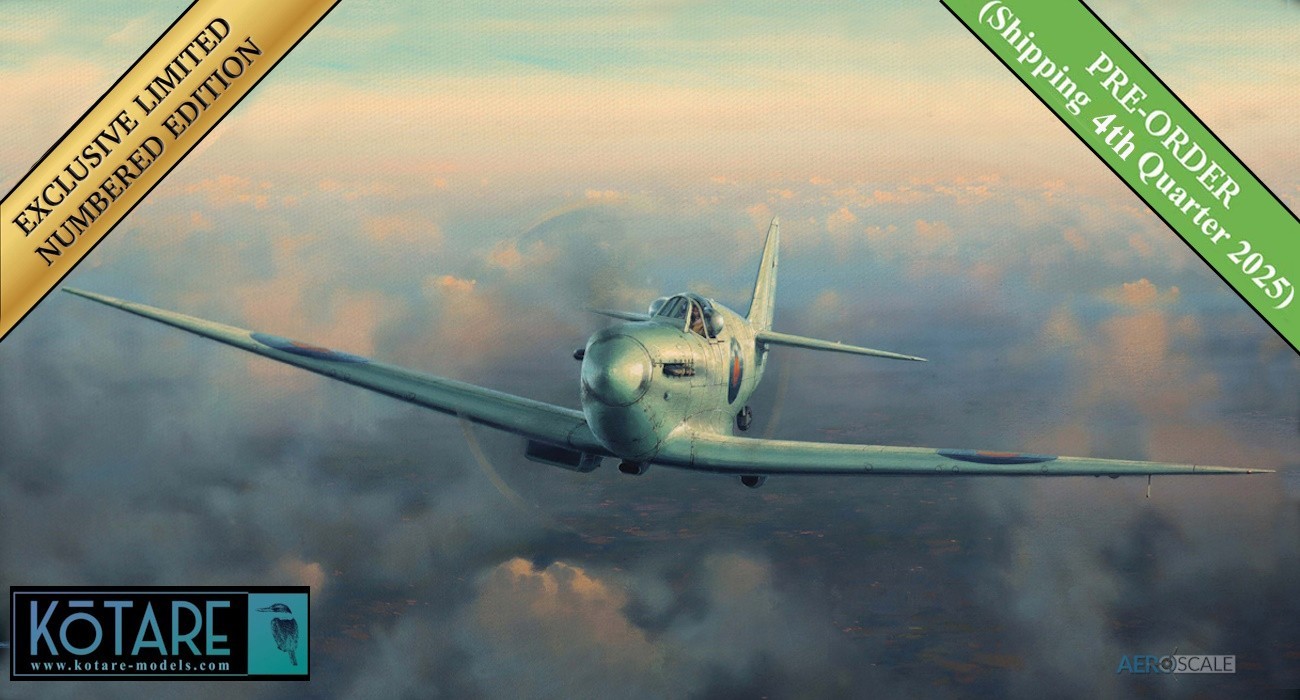
Introduction
Colors & Markings of the F9F Cougar in U. S. Navy & Marine Corps Service is an information packed book for modelers and enthusiasts of the early U.S. Navy jet, by Detail & Scale. It is volume 1 of their Colors &Markings Series.
Colors & Markings of the F9F Cougar covers every unit that ever flew the Cougar in 121 pages, 196 photos (85 in color), with 74 full color profiles and dozens of additional illustrations. That is the print version, catalogued with ISBN 979-8-5751818-0-4. The electronic Kindle and Apple formats feature 173 pages, 199 photos (91 in color), and 74 full color profiles.
The wingman - or flight lead - book is F9F Cougar in Detail &Scale—Revised Edition, presented through 102 pages, 270 photos (192 in color), plus 23 color profile & illustrations. Please see the review, here:
THE COMPLETE LIST OF DETAIL & SCALE AVIATION PUBLICATIONS REVIEWS
About the Book:
The Grumman F9F Cougar was an iconic Navy fighter,being one of two swept-wing aircraft rapidly developed from existing straight-wing designs already operational. Facing a disadvantageous situation in the air war over the Korean peninsula with outmoded aircraft, and yielding the air superiority mission to the United States Air Force F-86 Sabre, swept-wing developments of Grumman’s F9F Panther and North American’s FJ Fury gave the Navy the opportunity to field swept-wing fighters in the quickest possible time, far faster than developing a completely new design.
Detail & Scale has chronicled the history of the Cougar in detail in their F9F Cougar in Detail & Scale—Revised Edition. They now complement that publication with Colors &Markings of the F9F Cougar in U. S. Navy and Marine Corps Service, a comprehensive look at the paint schemes used on this iconic Navy fighter and the squadrons that flew it.
Detail and Scale books are excellent sources for modeling and history. They impressed me then and yet only recently have I comprehended just how comprehensive they are. Founders and authors Bert Kinzey and Rock Roszak bring over 60 years of first-hand military aviation expertise into their Detail and Scale brand. Roszak, a USAF navigator who retired as a colonel, creates illustrations for the books. Both of the Detail and Scale creators are modelers, too.

Content
Colors & Markings of the F9F Cougar in U. S. Navy& Marine Corps Service subjects are:
Forward
Introduction
Cougar Paint Schemes
Overall Gloss Sea Blue
Light Gull Gray Over White
Training Schemes
Drone & Drone Controller Colors
Cougar Squadrons
Navy Fighter Squadrons
Navy Attack Squadrons
Navy Photo Recon Squadrons
Navy Training Squadrons
Navy Fleet Air Service Squadrons
Marine Squadrons
Reserve Squadrons
Test & Evaluation Squadrons
Miscellaneous Squadrons
Blue Angels
Forward is an interesting page that tells the lineage of this book; from its first publication in 1984 the material has burgeoned to the point that it was deemed too big even for the digital format, and divided into the two books aforementioned. Introduction discusses the book in relation to other D&S books, basic Cougar history, and the general overview of this content. It explains how sweeping the wings of the F9F Panther did not result in a new aircraft type,just a new aircraft name: F9F Cougar. It also notes the dumbing down of USN nomenclature in 1962 (because SecDef McNamara and his “Whiz Kids” couldn’t understand it).
Twenty-one pages present the previously listed Cougar Paint Schemes: Overall Gloss Sea Blue; Light Gull Gray Over White; Training Schemes; Drone & Drone Controller Colors. It includes excellent information about the interior colors used for primer and corrosion control. That subject is often contentious amongst modelers but the facts come straight from first-hand knowledge - one of D&S’ sources was a Navy aircraft mechanic. Each sub-chapter gives a background and explanation of the subject color schemes, and lavishly illustrates the subject with well captioned photographs. We learn about those silver leading edges of USN aircraft, when colors were gloss or flat, size of warning symbols, and unique walkways applied to some aircraft. We are also introduced by name to military directives dictating paint schemes. For later reference a table lists the colors used on Cougars, by color name and Federal Standard (FS) number.
The93-page bulk of this book is eye-candy: Cougar Squadrons. Each squadron type (Fighter, Attack, etc.) receives a basic history of the mission and other aircraft types in their community. Herein we learn about each unit that flew Cougars, including the squadron nickname (some of which are headscratchers). With a few exceptions, each unit has at least a page dedicated to it and its deployments, illustrated with at least one photograph and original artwork of an aircraft, and the armorial ensign (squadron insignia). With 32 Navy squadrons flying Cougars on active duty, you can look forward to scores of fascinating images.
Units are presented with remarks about tail codes and Modex number series per deployment; aircraft used before and after the Cougar are often listed. For simplicity I include what artwork enhances each squadron history.
Navy Fighter Squadrons
VF-13 “Aggressors”: Gloss Sea Blue (GSB) F9F-8, BuNo. 131095, Sept. 1954; Light Gull Gray over White (G/W) F9F-8, BuNo.131081; armorial ensign.
VF-21 “Mach Busters”: GSB F9F-8, BuNo.131047; Inscription for coast-to-coast speed record participation
VF-24 “Corsairs”: GSB F9F-6, BuNo.131062.
VF-32 “Swordsmen”: GSB F9F, BuNo.138892
VF-33 “Tarsiers”: GSB F9F-6, BuNo. 128144
VF-43 “Falcons”: G/W F9F-8, Modex 208.
VF-51 “Screaming Eagles:”: GSB F9F-6 BuNo. 128142, CVA-47, 1953.
VF-53 “Blue Knights”: GSB F9F-8, BuNo. 141035; G/W F9F-8, Modex 308.
VF-61 “Jolly Rogers”: GSB F9F-6, BuNo. 130961, CVA-39; G/W F9F-8, Modex 209.
VF-63 “Fighting Redcocks”: GSB F9F-6, Modex 206.
VF-73 “Fighting Seventy-Three”: armorial ensign but no aircraft profile (artwork)
VF-74 “Bedevilers”: GSB F9F-8, BuNo. 131167
VF-81 “Crusaders“: F9F-8, BuNo. 141068; G/W F9F-8, BuNo. 141099; G/W F9F-8, Modex 212 with new squadron color and fuselage band; no photograph
VF-91 “Red Lightnings”: G/W F9F-8, Modex101
VF-93 “Blue Blazers”: no photos; GSBF9F-8 BuNo. 131251; F9F-8, Modex 310 with elaborate fuselage band
VF-94 “Tough Kitty”: no photo; G/W F9F, Modex 105; F9F, Modex 103
VF-103 “Sluggers”: no photos; GSB F9F-6, BuNo. 127283 with elaborate blue tulip with yellow lightning and red arrow on nose; G/W F9F, USS Coral Sea
VF-111 “Sundowners”: armorial ensign but no aircraft profile
VF-112 “Armed Keepers of the Peace”: GSB F9F-6, Modex 207; GSB F9F-8B, BuNo. 141073
VF-113 “Stingers” features their armorial ensign with aircraft to be shown in the Navy Attack Squadron Section
VF-121 “Pacemakers”: armorial ensign but no aircraft profile
VF-122 “Black Angels”: GSB F9F-8, BuNo.131197
VF-123 “Haley’s Comets”: G/W F9F-8, BuNo. 144353
VF-142 “Fighting Falcons” adorned their jets with golden falcons and ornate diamond bordered bands; GSB F9F-6, BuNo.127454
VF-143 “Cougars”: armorial ensign and color photos but no aircraft profile
VF-144 “Bitterbirds”: G/W F9F-8B, Modex 404; G/W F9F-8B, BuNo. 144301; G/W F9F-8B, Modex 201
VF-153 “Blue-Tail Flies”: odd name but beautiful jets; G/W F9F-8/8B, Modex 307
VF-173 “Jesters”: GSB F9F-6, BuNo.127453
VF-174 “Hellrazors“: three and a half pages of color photos and art; GSB F9F-6, BuNo. 127305; GSB F9F-6, BuNo. 127222
VF-191 “Satans Kittens”: armorial ensign and color photos but no aircraft profile
VF-192 “Golden Dragons”: features their armorial ensign with aircraft to be shown in the Navy Attack Squadron Section
VF-214 “Volunteers”: armorial ensign and color photos but no aircraft profile
Navy Attack Squadrons
VA-26 “Skylancers”: G/W F9F-8, BuNo. 141193
VA-36 “Road Runners”: G/W F9F-8, BuNo. 141177
VA-43 “Mach Busters/Challengers”: armorial ensign and color photos but no aircraft profile
VA-46 “Clansmen”: armorial ensign and color photos but no aircraft profile
VA-56 “Boomerangs/Champions”: G/W F9F-8, BuNo. 144344
VA-63 “Fighting Redcocks”: G/W F9F-8, BuNo. 141210; G/W F9F-8, BuNo. 141198
VA-66 “Waldomen”: G/W F9F-8B, BuNo. 131095
VA-76 “Spirits of ‘76”: G/W F9F-8, BuNo. 144294; G/W F9F-8, Modex 308
VA- 106 “Gladiators”: G/W F9F-8, BuNo. 141133
VA-113 “Stingers”: GSB F9F-8, BuNo. 138893
VA-126 “Fighting Sea Hawks”: GSB F9F-8, BuNo. 138830; rare all-white TF-9J, BuNo. 147389
VA-127 “Royal Blues”: armorial ensign and color photos but no aircraft profile
VA-146 “Blacktails”: G/W F9F-8, Modex 603
VA-151 “Black Knights”: armorial ensign but no photos nor aircraft profile
VA-156 “Iron Tigers”: armorial ensign but no photos nor aircraft profile
VA-192 “Golden Dragons/Goofy Loopers”: G/W F9F-8, BuNo. 141172
VA-214 “Volunteers”: armorial ensign but no photos nor aircraft profile
Interestingly, none of the following have armorial ensigns.
Navy Photo Recon Squadrons
USN actually fielded two photographic squadrons, VC-61 and VC-62. These two squadrons were also designated VFP-61, VFP-62, VFP-63, VCP-62and VCP-63. There were also photo recon training units. This chapter explains how Navy photo reconnaissance Cougars were allocated and deployed, as well as other photo recon aircraft types.
VFP-61: G/W F9F-8P, BuNo. 141726
VFP-61, Det J: G/W F9F-8P, BuNo. 144408
VC-62: GSB F9F-6P, BuNo. 131255
Navy Training Squadrons
USN had six training squadrons when two-seat Cougar trainers were fielded. Those squadrons were designated Advanced Training Units (ATU), redesignated as VT (training squadron) in 1960. These aircraft wore vivid white with high-visibility colors. Their squadron markings were often elaborate.
VT-23: TAF-9J (F9F-8B), BuNo. 144296
VT-26: TF-9J, BuNo. 147299
VT-26: TF-9J, BuNo. 142965
Navy Fleet Air Service Squadrons
A brief description of FASRON units.
Marine Squadrons
A brief description of the four Marine squadrons that flew the Cougar. In addition to attack squadrons, the Marines had six Headquarters & Maintenance squadrons, two Photographic-Reconnaissance squadrons, three Aircraft Repair squadrons, and six training squadrons.
VMA-533: G/W F9F-8, BuNo. 141057
VMJ-2: G/W F9F-6P, BuNo. 128298
H&MS-13: G/W TF-9J, BuNo. 147384, Vietnam
H&MS-13: G/W TF-9J, BuNo. 147335, Vietnam
Reserve Squadrons
A brief description of the Reserve Squadrons that flew the Cougar.
NAS Los Alamitos: GSB F9F-6, BuNo. 128085
NAS Los Alamitos: F9F-8, BuNo. 131226, in high-vis training scheme
NAS Willow Grove: GSB F9F-6, Modex101
Test & Evaluation Squadrons
The facilities Cougars were assigned to for special purposes. There were three test and evaluation units, VX-2, VX-3, and VX-5.
Pacific Air Missile Test Center, Point Magu: red/orange/yellow F9F-6K2 drone, BuNo. 130962
China Lake: drone controller F9F-6D, BuNo. 126246, painted Engine Gray, Orange Yellow, and Insignia Red
VX-5: GSB F9F-8B, BuNo. 131075
Miscellaneous Squadrons
NACA/NASA Cougars, and those in roles that don’t fit in above.
NASA: GSB F9F-7, BuNo. 131864, sporting a modified NACA/NASA badge
VA-45: TF-9J, BuNo. 142469, trainer livery
Blue Angels
Blue Angel Cougars receive four pages of history and colorful images.
F9F-8, BuNo. 131205, CDR Zeke Cormier
F9F-8T, BuNo. 142470, No. 0
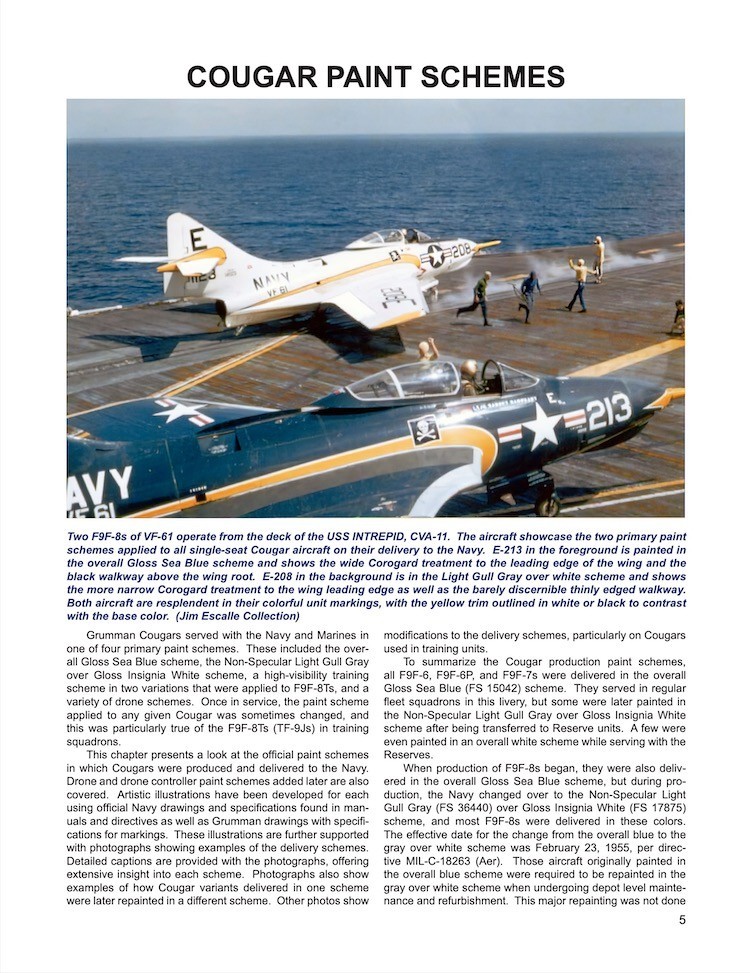

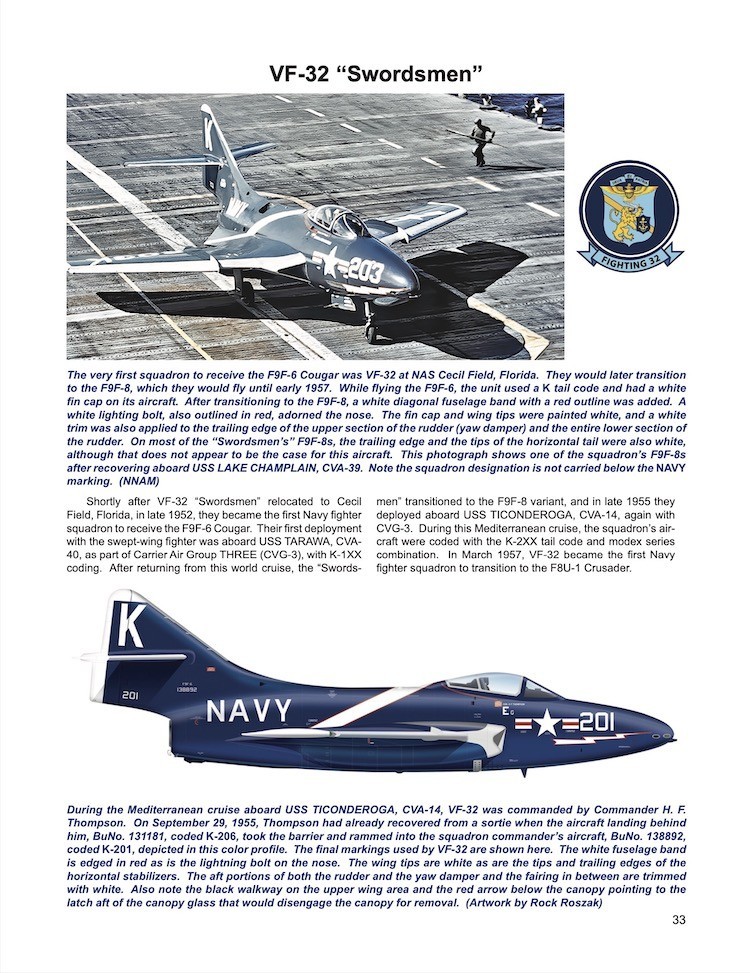

Photographs, Artwork, Graphics
Photos
As with other D&S books I have reviewed, this text is richly supported with color and black-and-white photography. D&S populates the book with a gallery of choice images, a signature strength of the series. Each image in this book can be considered studio quality. Such clarity affords the reader to see fascinating detail. The authors point out that rescue and warning markings could vary widely in placement outside of fighter and attack squadrons. USN's early jets were born in the era of Kodachrome and the revolution of easily obtained high performance color film. Naval aircraft of the era were very colorful and this book vividly presents that fact. So supreme is the printing that some color photos of trainers with florescent red-orange are incredibly intense and almost hurt my eyes! You will also find excellent color views of carrier deck colors.
I was surprised to learn that a few Cougars lasted into the 1980s in unique roles other than drones. Modelers and historians should find intriguing images in this book. A notable few are:
· USMCTF-9J used as a Fast FAC in Vietnam
· An Essex-class flight deck, while stained brown, shows no sign of plank construction
· Blue Angels No.7 receiving aerial refueling from an A-6 Intruder
· Flight deck scenes with aircraft tugs and other equipment
· A Cougar with the entire inner wing painted Corogard
· Heavily weathered jets, both from the elements, and maintenance
· Cougar being hoisted aboard an aircraft carrier
Artwork
I deviated from my routine and listed each of the original color aircraft profiles with its respective squadron history. All are profiles, most with landing gear up. Artist Rock Roszak made them a standard size although there are a handful that are smaller. They are clear, appropriately detailed, and show muted highlights and shading. Other illustrations include:
1. Overall Gloss Sea Blue Paint Scheme Diagrams with color F9F profile, top and bottom planform:
a. National insignias and service markings
b. Arresting hook and speed brake
c. Aluminum Corogard areas
d. Approach and navigation light cavities
e. Walkways
2. Non-specular Light Gull Gray Over Gloss Insignia White Paint Diagrams with color F9F profile, top and bottom planform:
a. National insignias and service markings
b. Arresting hook and speed brake
c. Aluminum and red Corogard areas, rain erosion resistance coating
d. Approach and navigation light cavities
e. Walkways and anti-glare panel
f. Jet intake warnings
3. First F9F-8T Delivery Scheme Paint Diagrams with color F9F profile, top and bottom planform:
a. National insignias and service markings
b. Arresting hook and speed brake
c. Aluminum and red Corogard areas, rain erosion resistance coating
d. Approach and navigation light cavities
e. Walkways and anti-glare panel
f. Jet intake warnings
g. International Orange applications per BuNo. coverage areas
h. Note on official walkway directive
4. Second F9F-8T Delivery Scheme Paint Diagrams with color F9F profile, top and bottom planform:
a. National insignias and service markings
b. Arresting hook and speed brake
c. Aluminum and red Corogard areas, rain erosion resistance coating
d. Approach and navigation light cavities
e. Walkways and anti-glare panel
f. Jet intake warnings
g. Unpainted areas
h. Note on official walkway directive
Tables
Many tables present information and data in easily digestible formats.
a. F9F Cougar and the DoD Redesignation of aircraft designations: nine designations pre- and post- Sept. 1962, i.e., F9F-6 became F-9F, F9F-8B became AF-9J.
b. Federal Standards 595 colors associated with standard Cougar paint schemes: 13 colors.
c. Grumman F9F Cougar Fighter Squadrons: 32units listing Squadron number; Nickname; Tail Code(s); Notes (those converted to Attack mission).
d. Grumman F9F Cougar Attack Squadrons: 20 units listing Squadron number; Nickname; Tail Code(s); Notes (several subjects).
e. F9F Cougar Training Squadrons: 6 units listing Pre-1960 Squadron number; Post-1960 Designation; Nickname; Tail Code.
f. FASRONs hosting F9F Cougars: 16 units listing FASRON number; Location.
g. USMC Cougar units: Unit designation; Nickname; Tail Code.
h. HQ & Maintenance Squadrons: Unit; Tail Code.
i. USMC Training Squadrons: Unit; Tail Code.
j. USMC Aircraft Repair Squadrons: Unit; Tail Code.
k. Reserve Squadrons: Base; Tail Code.
l. Test & Evaluation Squadrons: Facility; Location.
m. Air Development Squadron: Unit; Tail Code.
n. Miscellaneous Squadrons: Unit; Tail Code; Type of Cougar.
Those tables are perfect for quick reference. The painting and marking diagrams show, clearly and easily followed, essential knowledge for properly painting and finishing your Cougar. The photographs provide clear visual verification of standards and exceptions of colors and markings of this Grumman cat. And of course, the numerous color profiles remove variations of color caused by lighting, film processing, and weathering to standardize the colors these cats wore. These visuals support and enhance the text unequivocally.
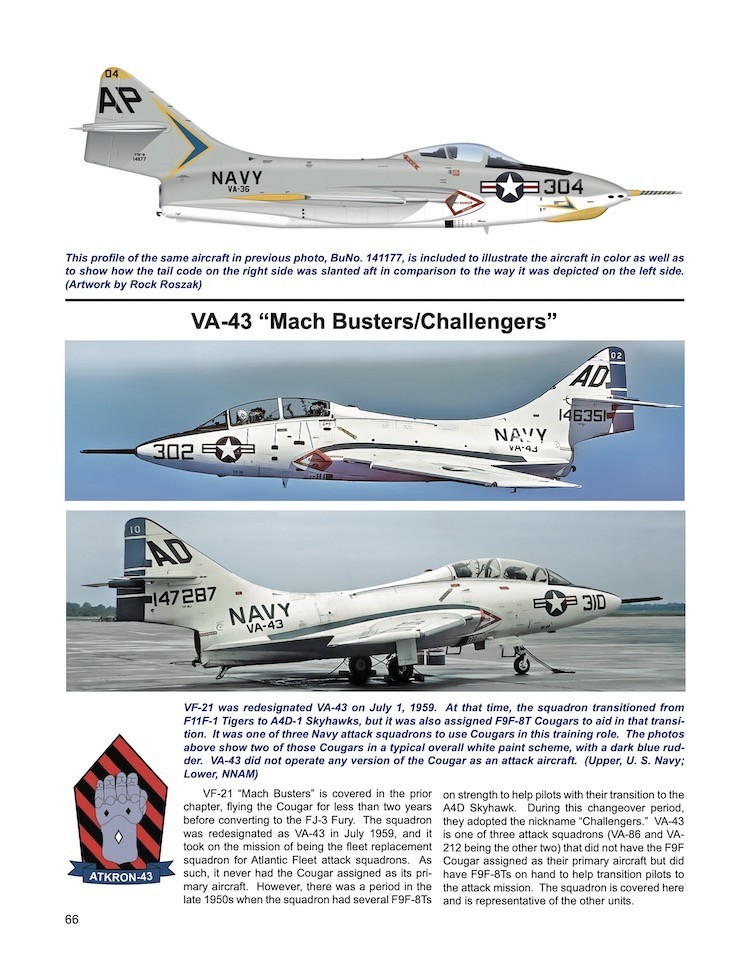
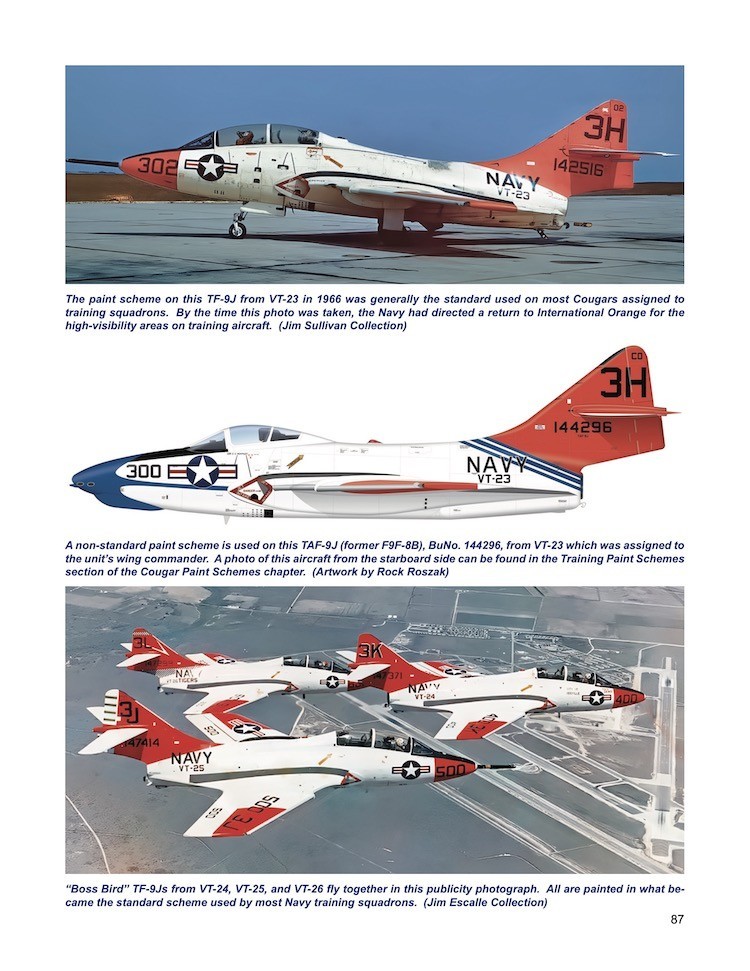
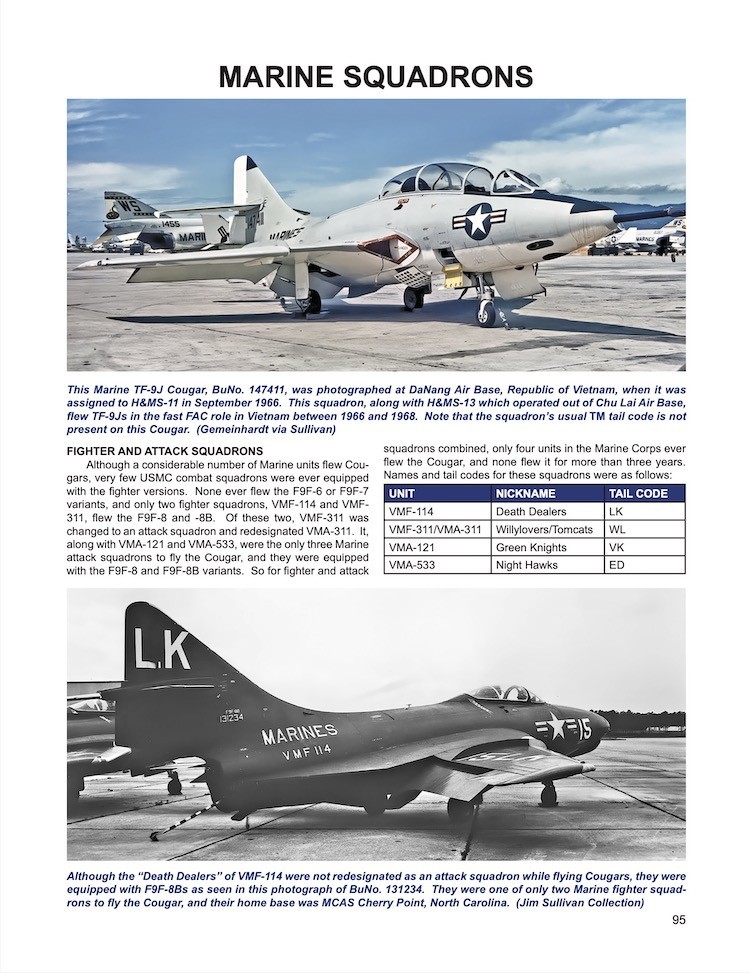
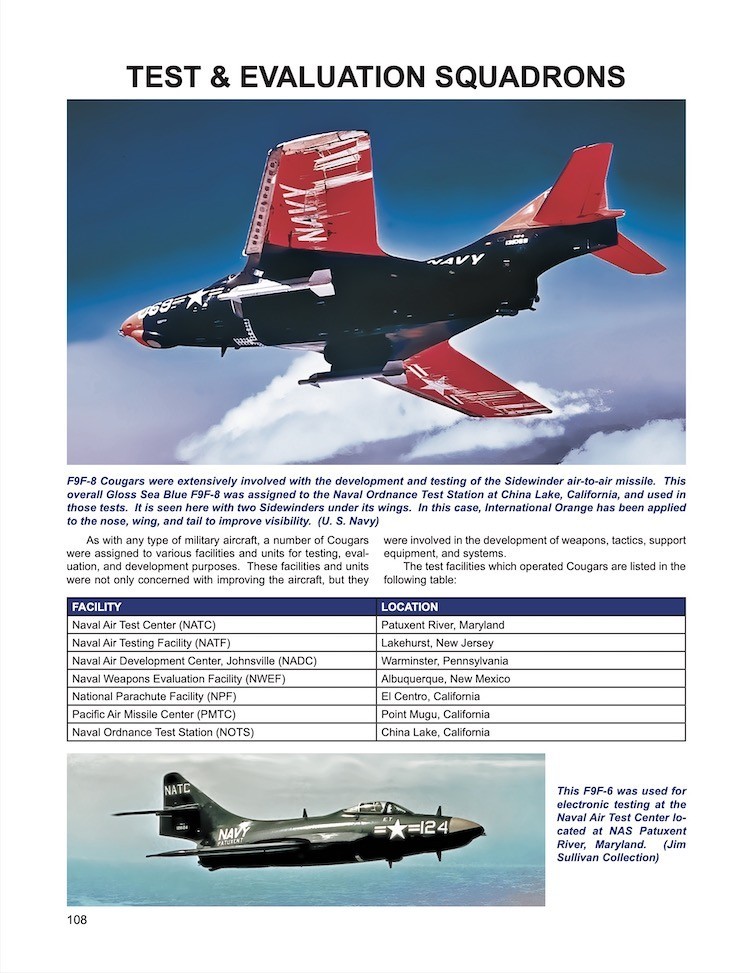
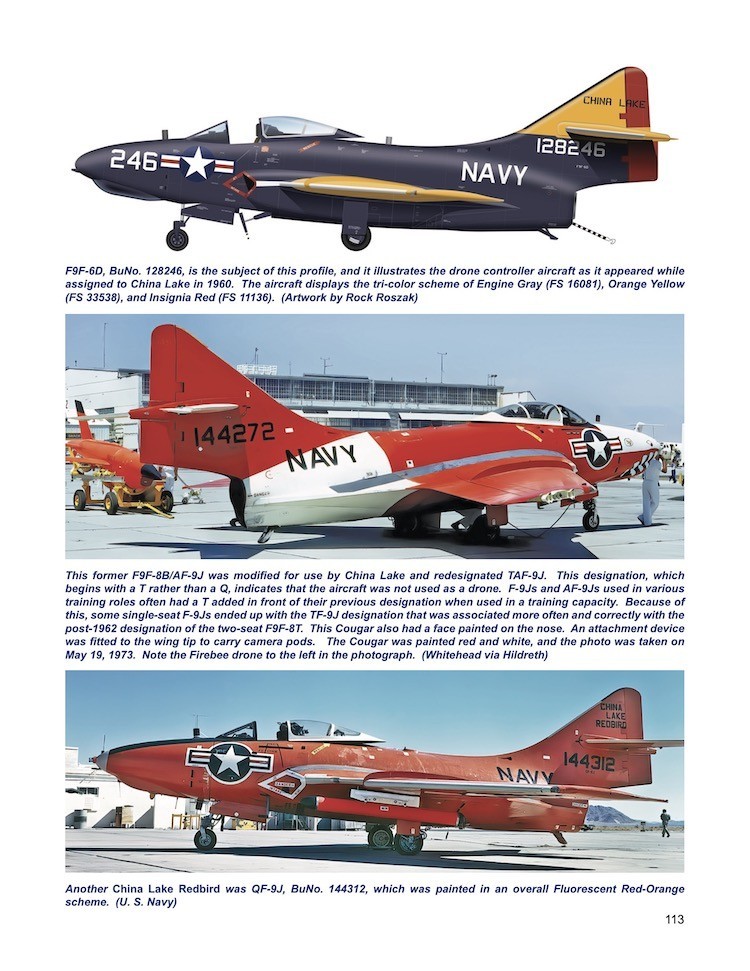
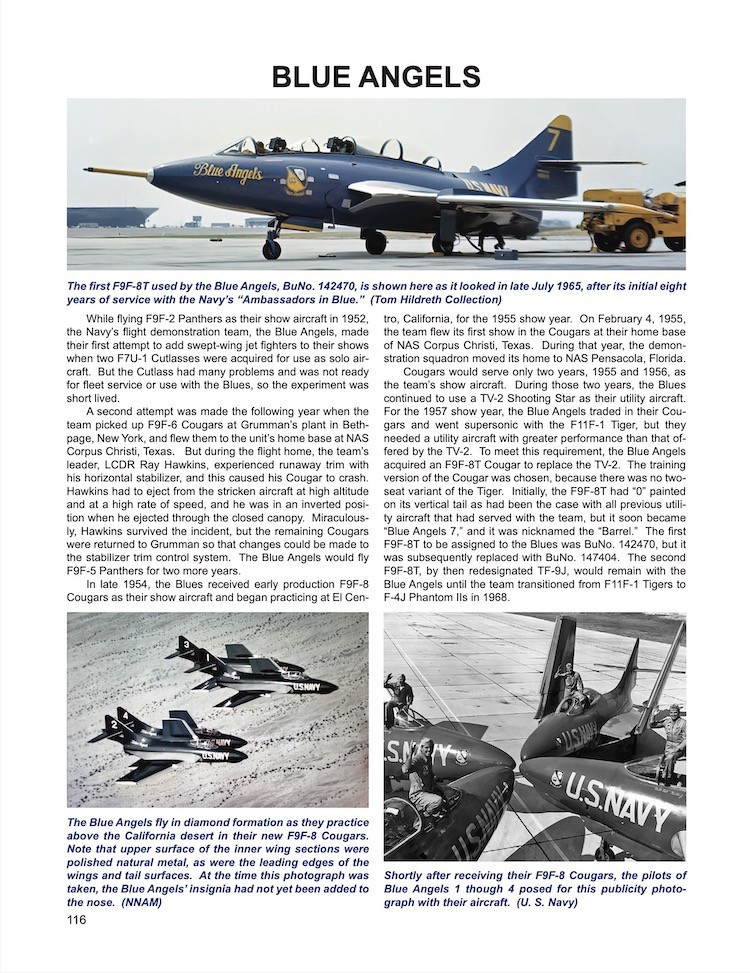
Conclusion
Colors & Markings of the F9F Cougar in U. S. Navy & Marine Corps Service is another exceptional aircraft presentation by Detail in Scale. I do not know of every book about the Cougar but between this title and the nuts-and-bolts title, I haven’t found a more comprehensive history of Grumman’s first swept-wing cat. In great detail the excellent text and an extraordinary gallery of photographs and illustrations bring the Cougar to life for modelers, artists, and historians. Tables present useful and interesting data effectively.
I can't think of any meaningful complaints about this book. Modelers and students of the F9F Cougar, Cold War combat aircraft, and early Naval jets should be thrilled with this book. Enthusiastically recommended.
Please remember, when contacting retailers or manufacturers, to mention that you saw this product highlighted here - on AEROSCALE.




















